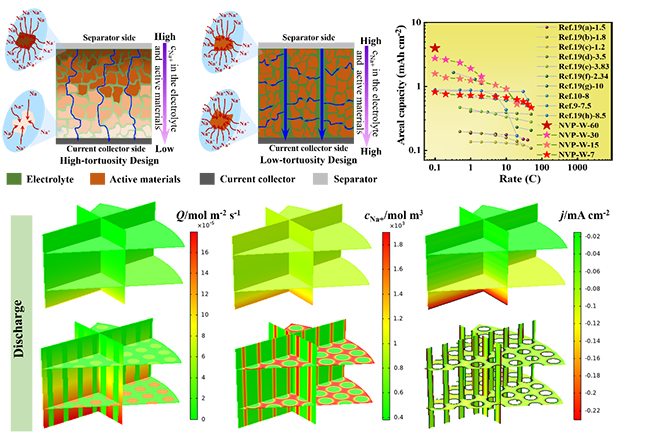Due to their large-scale energy storage, sodium ion batteries (SIBs) are a promising alternative to lithium-ion batteries (LIBs). However, it's challenging to develop high-energy and high-power SIBs due to the greater atomic mass and larger ionic radius.
Electrode architecture design with high mass loading of active materials is a more straightforward strategy to achieve high energy. It can increase the percentage of active materials and consequently energy density at device/cell levels.
Recently, a research group led by Prof. LI Xianfeng and Dr. ZHENG Qiong from the Dalian Institute of Chemical Physics (DICP) of the Chinese Academy of Sciences (CAS) designed and optimized a low-tortuosity and high-areal-capacity cathode for high rate and ultra-stable SIBs.
The results were published in Advanced Energy Materials on March 18.

Schematics illustrating the ion transport pathways in diverse electrodes (Image by LV Zhiqiang and YUE Meng)
The researchers reported a low-tortuosity, finger-like composite electrode with ultra-high mass loading based on nonsolvent-induced phase separation method, which could offer well-pleasing electron/ion transport pathway and relatively low battery resistance.
Benefiting from the structural advantages, they achieved the as-prepared electrode with ultra-high mass loading (60 mg/cm2) and areal capacity (4.0 mAh/cm2). Even at a high rate of 10 C, the areal capacity remains 1.0 mAh/cm2.
The researchers also illustrated the homogeneous Na+ distribution, gentle and uniform local current density and polarization inside the as-prepared electrode.
Combining numerical simulations and experiments, they revealed that the low-tortuosity architecture could contribute to an impressive ion transport capability and consequently significant improvements in electrochemical performance.
This study exhibits a prospective solution for the design and optimization of the low-tortuosity electrodes with ultra-high mass loading, which opens a new door for developing advanced SIBs with high energy/power density.
This work was supported by the Strategic Priority Research Program of the Chinese Academy of Sciences, the National Natural Science Foundation of China, Youth Innovation Promotion Association of CAS, and the Dalian National Laboratory Cooperation Fund, CAS. (Text by LV Zhiqiang and YUE Meng)